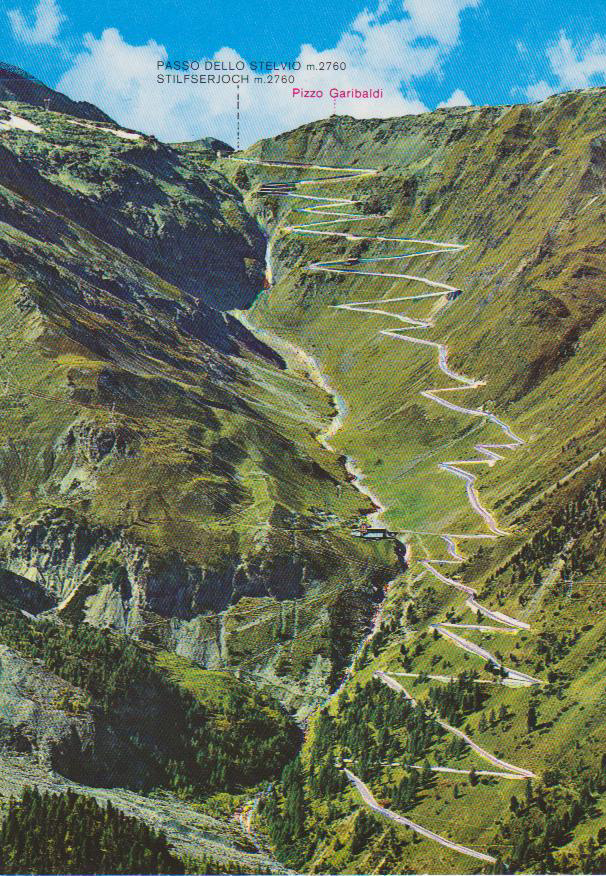Passo dello Stelvio
Stelvio Pass, in German: Stilfser Joch
Its cycling history, statistics, photos and map
Statistics | Passo dello Stelvio in cycling history | Photos | Map |
Back to KOM Italian climbs | Back to KOM index page

Final switchbacks of the Stelvio's north face.
Stelvio Pass statistics:
The north side of
the Stelvio Pass is the iconic, legendary climb in the picture above. The south side is also quite tough, however. The Stelvio is Europe's second-highest paved pass. Only France's Iseran, at 2,770 meters, is higher.
Here are the numbers for the north face, approaching from Prato allo Stelvio
Average gradient: 7.4%
Maximum gradient: 11% (in the last kilometer)
Length: 24.3 km
Elevation at the start: 950 meters
Elevation at the crest: 2,758 meters
Elevation gain: 1,808 meters
The north face has 48 numbered switchbacks, but you have been climbing for a while out of Prato allo Stelvio before arriving at the countdown's beginning. This is a monster climb of stunning beauty
The Stelvio Pass in cycling history
I rode the Stelvio in 2002

There is evidence that the pass was used as far back as the bronze age as a route to get from what is now Tyrol to Italy. At the end of Napoleonic wars the winners (Russia, Prussia, Britain, etc.) held a convention, the Congress of Vienna, in which these triumphant imperialistic powers worked to impose the old order on Europe. They set about redrawing the map of Europe. The northern region of Italy of which Milan is the capital, called Lombardy (Lombardia in Italian), was given to the Hapsburgs who ruled the Austro-Hungarian Empire. This transfer of territory was to make up for their loss of the Netherlands. Italy as a country did not then exist. It was several separate countries, mostly ruled by other European powers.
The Austrians wanted a road to give them a clear communication between Austria, the Val Venosta and Italy through the region of Valtellina. The Italians were rebellious and control was impossible without a pass through the Dolomites. Plans to build the pass were made in 1813, but they were abandoned. In 1820, the Hapsburgs made another attempt and with 2,000 workers completed the incredible engineering feet in 1825.
After Italian independence and unification in the 1860's the top of the Stelvio was the border between Austria and Italy. After World War One, South Tyrol (more territory north of the Stelvio) was given to Italy. Today, the entire pass is in Italian territory.
The Giro d'Italia first included the Stelvio in 1953 when it was the penultimate stage. Fausto Coppi's ride that day is legendary. Since then the Giro has ascended the Stelvio from both the north and the south: 1965, 1972, 1975, 1980, 1994, 2005 and 2012. It was scheduled into the 2013 Giro, but bad weather forced its removal.
In the 1984 Giro the Stelvio was supposed to be climbed from the south, but it was removed under circumstances that cycling fans still argue about. It is said that to prevent climber Laurent Fignon from gaining too much time on non-climber Francesco Moser, the Stelvio was eliminated. Moser went on to win the 1984 Giro.
Including the Stelvio and the the other ultra-high Dolomite passes always presents a risk to the Giro organizers because in May the possibility of bad weather is always present. Note that the pass has snow in all the racing photos below.
Our mountains expert, Larry Theobald of CycleItalia, explains the climb:
I saw the famous pass in-person for the first time in 1994 but didn't get to ride my own bike up from Prato allo Stelvio to the top until 1997. Some describe the pass as Alpe d'Huez with the Passo Pordoi as a warmup. That's right, at just over 24 kilometers this monster is the same length and average grade as both of those combined.
For me there are three distinctive phases of the climb - the first one, starting at Prato gives you a good warmup long before you reach switchback 48 where the first inkling that your are tackling a mythical climb is confirmed. From here you get a bit of encouragement as you can knock off a couple of numbers in quick succession, but it's a tease. Some of these ramps are very steep and uneven in grade, but in the shade of the trees you can hear cowbells as you pass the small ski villages, and since you can not see the summit, you continue along in a sort of blissful ignorance.
This ends with with the beginning of the second phase. You round a curve to the right and suddenly are faced with that famous postcard image of the road lacing its way up, up, up as the trees give way to scrub and scree. You start to realize just how far you have to go as you strain to see the summit. At first you fear it's the round "Free Tibet" building, but then you realize (or perhaps a fellow climber points out) the summit's not quite that high, rather it's in that low spot you can just make out with the naked eye.

Looking up from switchback number 24.
Phase three is when you've gone far enough you begin to believe you can make it to the top. You still can't really see it, but the spray-painted kilometer markings are telling you you're close (they're pretty accurate) even though the numbered switchbacks continue to play tricks on you. You've counted down enough of them to realize, even with oxygen deprivation as you ascend to the 9000+ foot summit, they have no relation to the distance traveled, they simply count down the switchbacks in a rather arbitrary fashion.
At this point, depending on the time of year and weather, you might start recalling the iconic image of Fausto Coppi climbing alone, flanked by W COPPI scrawled into the snowbank by an enterprising photographer who waited there, poised for the shot he hoped to get of Un uomo solo al comando (a single man at the head of the race) or a later one of Ivan Basso suffering like a dog on this climb, watching his Giro chances slip away, but refusing to quit.
But the real treat, besides the feeling of accomplishment when you do finally make it to the top, is the "sizzle of the sausage on the Stelvio" as we like to say, as the vendors who line both sides of the summit road hawk their panini. Bratwurst or salsiccia, brown or white bread, with or without sauerkraut, ketchup, mustard or mayo? Cold beer or Coca-Cola? Some days in July it's warm enough to enjoy this at a picnic bench in the sun before putting on a wind jacket and descending to Bormio, while other days can find you grabbing the sandwich only after putting on every piece of clothing you own and sitting in the van, then skipping the freezing ride down, though it warms up pretty fast on the fast and technical descent, where some wet and dark tunnels spice things up.
I look forward to this challenge every chance I get, having done it 4 or 5 times since that first climb in 1997. 2014 will (I hope) my next chance.

Looking down the Stelvio from the top. CycleItalia photo

Fausto Coppi ascends the Stelvio in the 1953 Giro d'Italia

José-Manuel Fuente climbing the Stelvio in stage 17 of the 1972 Giro. Fuente won the stage.

The same stage, further back. Eddy Merckx is in difficulty. He finished the stage two minutes behind Fuente but won the 1972 Giro, 5 minutes 30 seconds ahead of second-place Fuente.

1980 Giro d'Italia, stage 20. Wladimiro Panizza climbs the Stelvio. He is on his way to losing the maglia rosa to Bernard Hinault.

The Stelvio as part of stage five of the 2005 Giro d'Italia. Fabio Parra won the stage.

The pack ascends the Stelvio south face in teh 2012 Giro d'Italia

Larry Theobald of CycleItalia riding up the Stelvio's north face.

Even in June snow is still around. CycleItalia photo

Heather Reid of CycleItalia takes a break.
Map:

Map of the Stelvio and Gavia passes.

The Stelvio's north face ascent is generally regarded as starting from Prato allo Stelvio, in the upper right. The crest is at the red dot.
Back to KOM Italian climbs | Back to KOM index page







